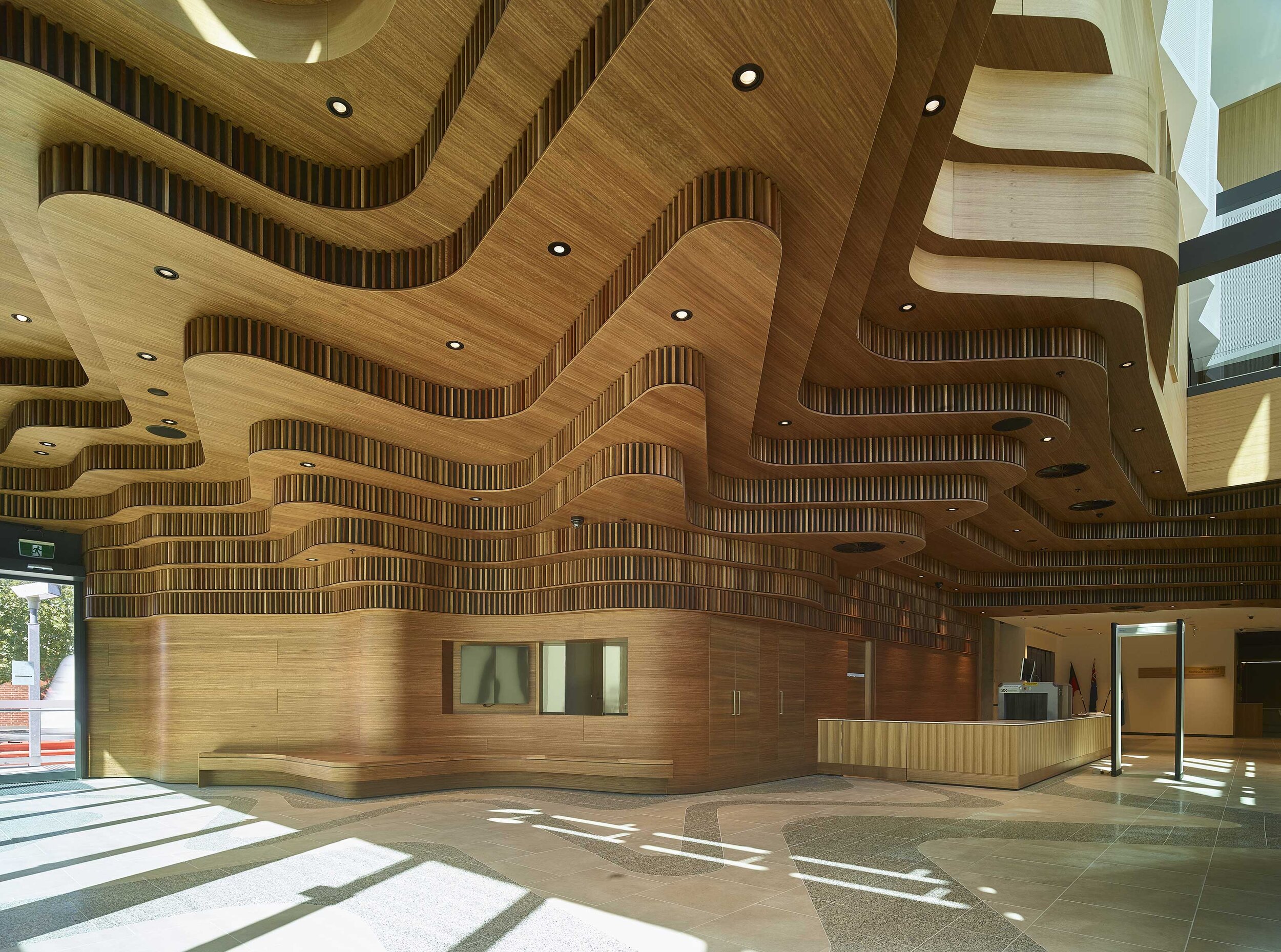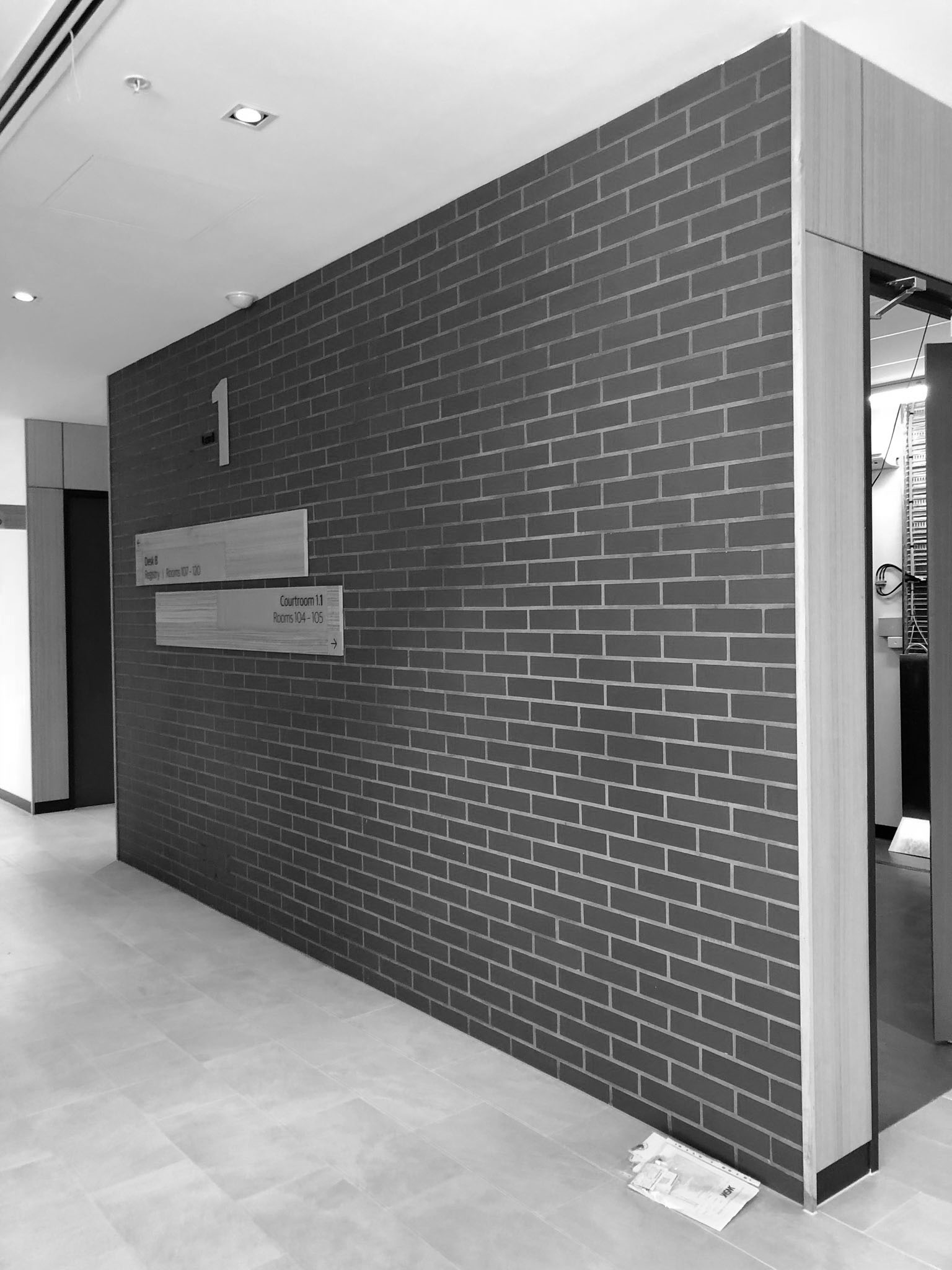Like all design exercises, there is a range of considerations when designing for Courts. Through this article, we will explore nine of these considerations – humanity, symbolism, tradition, innovation, security, efficiency, workplace, safety and technology – and how they influence the way we design justice architecture.
1. Humanity
One of the reasons “courtroom dramas” feature so heavily in books and movies is the heightened emotions and various tensions surrounding most judicial events. This, combined with the potential for the justice system to be seen as imposing and institutional, can create a de-humanised experience.
A key challenge for court designs is to mitigate, or at least not exacerbate, the feelings of anxiety, fear or intimidation that many feel when thrust into the Court system. The designer needs to be aware of issues around dignity, legibility and equity in contemporary courtroom design.
How does this translate to bricks and mortar or chairs and tables? A good example here is the question of the witness stand or dock.
“Research suggests that a defendant sitting in a glass-encased dock is twice as likely to be convicted…. Meanwhile, the jury is out on whether body language can be interpreted – should witness boxes conceal the person giving evidence? …and should a jury table be round, oval or rectangular, to avoid one person being seen as unequal?”
Ray Edgar, “New Shepparton court building tackles stress through design” The Age 12/03/2018
2. Symbolism
Photography by: Scott Burrows Photographer
Courts are steeped in symbols and symbolism. This makes the need to harness or control the symbolic content of any court design a crucial element of the design.
Metaphor and ritual play a strong role in courts, from Themis (Lady Justice blindfolded with her sword and scales) on down. At Shepparton, the town's strong Koori culture features in the court entrance. Wrapped layered timbers abstract the Koori court logo of a giant tree and its roots. The projecting layers suggest a canopy, a metaphor for a protective and secure meeting place. The tree motif extends throughout the building and is inlaid into the Koori court table.
Ray Edgar, “New Shepparton court building tackles stress through design” The Age 12/03/2018
Symbolism ranges from the grander, large scale gestures such as the ‘tree’ as a central metaphor at Shepparton Courts of Law, a project designed in partnership with Architectus, to small elements such as having judges positioned a step or two above the majority of the court.
We're trying to make less of the authoritarian symbols visible, so it becomes more inviting, less threatening. Our focus is the support of occupants through these processes. For us, that's what a modern court building is about.
Mark Wilde, Architectus
3. Tradition
Photography by: Scott Burrows Photographer
As a key institution in the social fabric of modern society, Courts come freighted with layers of tradition. Many are essential to preserve and foster; others deserve to be challenged as to whether they meet contemporary expectations.
Which is which? An example of a tradition to foster is the viewing gallery which allows proceedings to be witnessed by any member of the public to ensure transparency and oversight. In contrast, the opportunity to innovate with technology illustrates where a traditional value (the right to see your accuser in court) can be adapted to modern practices.
Traditionally, courts would have been closed rooms employing rich detailing and prestige materials to reinforce the serious nature of proceedings and authority of the court. A contemporary change in court design is to create courts that are light, open and transparent with a clean, sophisticated use of materials.
An equally powerful and consistent metaphor is told through the building's materials – the court is either transparent or, for reasons of privacy, translucent.
Ray Edgar, “New Shepparton court building tackles stress through design” The Age 12/03/2018
4. Innovation
One consequence of tradition in courtroom design is the opportunity for innovation. A good example here is the increasing use of in-court technologies in most judicial systems. Remote witness testimony allows vulnerable witnesses to appear and testify without the stress that can flow from being close to the accused. From the simple proposition of telepresence flows a range of physical, psychological and logistical considerations for the architect designing the spaces.
Another example of innovation which impacts court design is the expansion of third-party support services such as the Court Network, Cubby House or therapy dogs. Increasingly these are viewed as important ‘soft’ support services, which are included in courthouses to assist people navigating the stress and strains of the judicial process. With each comes a web of proximities and relationships to consider, as well as the physical space and infrastructure for them to operate.
5. Security
The consideration of security comes in to play in a range of ways. Firstly, and possibly most obviously in a post 9/11 world, there is a need for venues to be secure from hostile intent. Many of these important issues are addressed well before attendants reach the courtroom through screening or scanning, control of access or surveillance.
Next is the thought that some in attendance may be in custody and literally, need to be secured. For prisoners or remandees in custody, this involves a considerable ‘back-of-house’ infrastructure leading to their arrival in court. Courts are also the location for confidential matters with other security considerations, for example, acoustic privacy.
6. Efficiency
Photography by: Guymer Bailey Architects
The delivery of justice and the court system in general, are a costly public service, which all Courts are well aware of and seek to improve. In addressing this, all courts seek to be efficient, while striking a delicate balance with being thorough. A similar balance needs to be struck in designing the spaces and place in a court. The obvious example here is circulation in a courthouse or court complex.
In most court projects there are at least four separate systems of circulation – public, staff, judges and persons-in-custody. There can also be separate paths for jurors and witnesses, particularly vulnerable witnesses. At face value, this is incredibly inefficient and requires considerable space, even multiple elevators leading to attendant expense. However, the need for judges and staff to be at ‘arms-length’, for witnesses to feel safe and those in custody to be securely held are more over-riding priorities than the simplest, minimum configuration of circulation.
An example of good efficiency gains on the design front can be found in great wayfinding. Enabling practitioners, the public and staff to move efficiently to a destination through clear signage and logical adjacencies provides effective efficiency.
Scale and space help people avoid confrontation. Clear wayfinding is also important.
Ray Edgar, “New Shepparton court building tackles stress through design” The Age 12/03/2018
7. Workplace
Photography by: Guymer Bailey Architects
Another consideration in the design process is approaching the design as a workplace – since it is for judges, counsel, court staff, etc. Some of these are employees of the court; others are in court as a part of their working day. An example of the impact of considering this in the design is evaluating screening systems and who is able to skip this process due to prequalification.
Some courts allow legal practitioners to have access passes. Others require all legal practitioners and police prosecutors, their paperwork or electronic evidence and so forth, to pass through screen systems. This simple choice significantly changes the process of arriving at court and the times and space involved.
Another example is the incorporation of opportunities for landscaping, plants and biophilia. A great example of this is the hanging gardens and breakout areas included in QEII Courts of Law in Queensland.
8. Safety
Safety and security are related, but different considerations. A secure facility can restrict access to only peoples expected to be there, but if it allows a distressed person to be violent, then it is unsafe. Safety also ranges from the physical to the emotional. An example of this is providing segregation between parties in conflict, or between judges and the public.
While these are important, technical aspects to get right in the design, due to the nature of the adversarial justice system, the key consideration for designers regarding safety is the creation of an emotionally safe space, where intimate, personal, or painful matters can be explored to establish truth, trust and deliver justice.
"It noted significant deficiencies…It wasn't really a safe environment…because [people are] often exposed and having to share the same space as the perpetrators."
Ray Edgar, “New Shepparton court building tackles stress through design” The Age 12/03/2018
9. Technology
Like most of modern society, evolving technology is having significant impacts on the operation of courts. This ranges from the inclusion of remote access/witness programmes to the use of multimedia, trial management systems or physical aids like iPads in use for juries. Our experience across numerous jurisdictions shows the careful consideration courts apply to the technologies that are beneficial.
A good example of the maximised inclusion of technology in courts can be seen in the Moot Court at Monash University. Created as a teaching space, it is also very much an exploration of what the next steps for integrated technology in courtrooms can be in the near future.
As you can see, the design of courts requires a complex, multifaceted consideration of the technical and intangible aspects that are part of the modern court. All play a part in the success of the spaces created, whether it is the layout, material selection, acoustics or embedded symbolism.





















